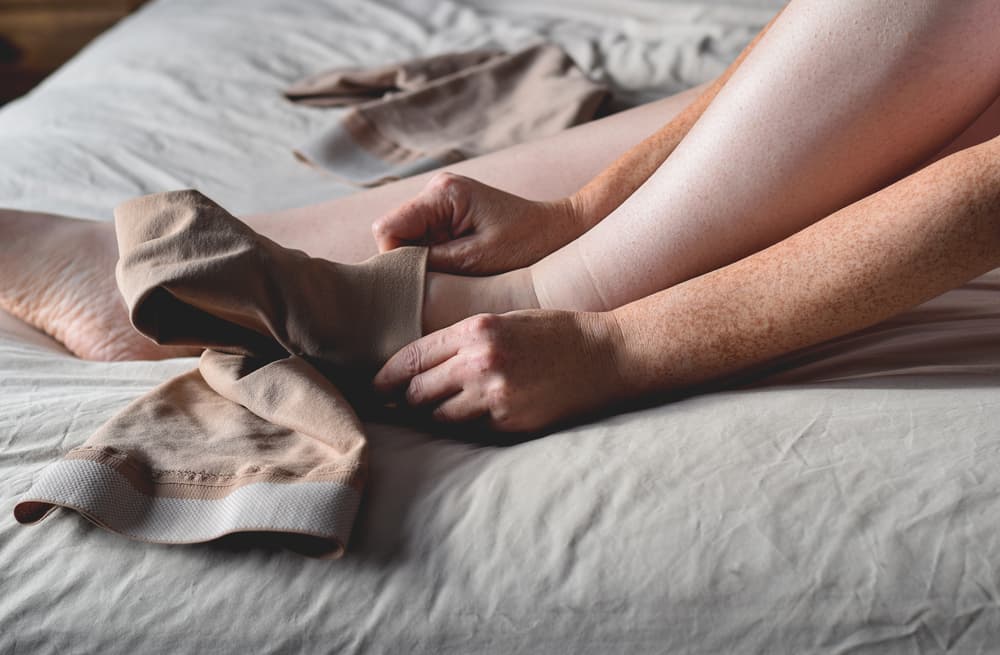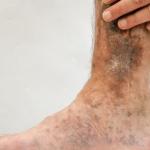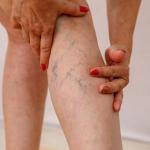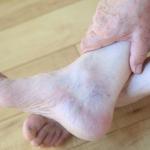
Topics Covered in this Blog:
- What is Compression Therapy?
- Types of Compression Therapy
- What are the Benefits of Compression Therapy for Legs?
- What are the Risks of Leg Compression Therapy?
- What to Expect with Compression Therapy
- A Note from USA Vein Clinics
Compression therapy may be right for you if you suffer from poor blood circulation in the lower legs. Leg compression therapy treats the pain and swelling associated with various conditions related to poor circulation. These can include chronic venous insufficiency and varicose veins. Compression therapy for legs helps increase blood circulation and helps to reduce pain and swelling. Compression therapy devices are available both over the counter and with a prescription.
What is Compression Therapy?
Leg compression therapy helps improve the blood flow in your lower legs and is a standard treatment for poor lower extremity circulation. It commonly uses elastic stockings, socks, or wraps. The stockings, socks, or wraps provide pressure on your legs, ankles, and feet that help prevent pooling blood and fluid build-up in these areas.
Types of Compression Therapy
There are several types of compression therapy available. They include:
- Compression socks: Compression socks are the size of regular socks. They offer compression of the ankles and feet and are great if fluid forms around your ankles. Compression socks are also available in knee-high length. Stockings that go up to the knee are the most common compression therapy.
- Compression stockings: Stockings offer two lengths. They can either go to the thigh or be in the form of tights that go to the waist.
- Inflatable devices: Inflatable devices are garments that cover the legs fully and inflate to provide compression therapy.
- Bandages and wraps: Velcro wraps and elastic bandages may be easier for people who have difficulty putting socks on. They are usually layered to help provide compression.
Compression devices have different rates of compression. They are rated by the manufacturer in either low, medium, or high compression. The amount of compression needed depends on the condition being treated. While there is no standard scale for rating compression stockings, the pressure is measured in mmHg or millimeters of mercury. There are three general categories of pressure.
- Low – Low compression is considered less than 20 mmHg
- Medium – Medium compression between 20 and 30 mmHg
- High – High compression is higher than 30 mmHg
You can get compression socks or stockings over the counter if they are low compression. If you are required to sit or stand for long periods or are pregnant, low-compression stockings may be beneficial to help prevent vein disease.
Both the medium and high compression usually require a prescription to obtain. Consult your doctor before purchasing over-the-counter compression stockings to see what pressure category is best for you. It is recommended that you are measured for medium and high compression stocking.
What are the Benefits of Compression Therapy for Legs?
Compression therapy is used for many conditions caused by poor circulation. Your healthcare professional can assist you in determining whether compression therapy for legs benefits you and how much compression is needed. Some of the conditions helped by compression therapy for legs include:
- Varicose veins – Chronic venous insufficiency is the cause of varicose veins. They look like raised, winding ropes under the skin. Compression therapy can relieve the swelling and pain of varicose veins.
- Deep vein thrombosis (DVT) – Deep vein thrombosis is a blood clot that forms within a deep vein in the body, primarily in the leg. A blood clot blocks blood flow and can cause swelling. If you are at risk for DVT, your healthcare professional may recommend compression therapy. Leg compression therapy may also be used if you already have a DVT and are on blood thinners. Some risk factors for a possible DVT include:
- Chemotherapy
- Immobility or physical inactivity
- Being overweight or obese
- Being pregnant or within six weeks after giving birth
- Chronic venous insufficiency – Chronic venous insufficiency occurs when the vein walls have weakened and the valves inside aren’t working correctly. This impairs blood flow between your legs and your heart and causes blood to build up in the legs. Multiple issues may cause chronic venous insufficiency. Age, prolonged sitting or standing, or deep vein thrombosis could be the causes of chronic venous insufficiency. Compression therapy treats chronic venous insufficiency with graduated pressure throughout the leg. The pressure helps push blood back to the heart against gravity.
- Edema (swelling of the legs, ankles, or feet) – When fluid becomes trapped in your tissues, it causes swelling. Gravity makes your feet the most likely area for the fluid to pool. Our bodies can prevent pooling in several different ways. There are conditions where the pooling will still occur. Compression therapy helps prevent fluid from accumulating by using pressure to keep the fluid moving.
- Swelling in your legs, ankles, and feet can be caused by:
- Congestive heart failure
- Pregnancy
- Chronic venous insufficiency
- Lymphedema
- Sitting or standing for long periods
- Swelling in your legs, ankles, and feet can be caused by:
- Orthostatic hypotension – Occurs when there is a rapid drop in blood pressure when you stand up. You may feel dizzy or lightheaded due to low blood pressure. It is due to the blood not returning to your heart properly from your feet when you stand. Since compression therapy squeezes blood from your legs back to your heart, it is used to treat orthostatic hypotension.
- Wounds and leg ulcers – Ulcers are open sores that can occur anywhere on your body. They often appear on the legs, ankles, and feet. People at high risk of developing wounds or ulcers include those with varicose veins, poor circulation, and diabetes.
Compression therapy for legs can help to improve circulation of the blood in the legs and curtail swelling and pain. It can help prevent deep vein thrombosis, heal ulcers, and manage chronic vein disease conditions. Compression socks are generally worn during the day and removed at night. However, there are times when bandages are used overnight to treat ulcers and sores. Your healthcare provider will provide you with instructions on your treatment plan.
Speak with your doctor to determine if compression therapy for legs will benefit you.
What are the Risks of Leg Compression Therapy?
The problems that people encounter with compression therapy are generally not severe. They include:
- Discomfort or pain may occur from the squeezing of the compression stocking or sock.
- Swelling of the toes or lower foot can happen because the compression is lower here.
- Skin irritation can happen for those sensitive to certain fabrics or due to the compression itself.
- Fungal or bacterial infection may occur if you sweat into the socks or stockings.
Some severe side effects can also occur, though these are rarer:
- Soft tissue damage
- Nerve damage
- Superficial Thromboembolism – A blood clot that occurs in the superficial veins immediately under the skin.
What to Expect with Compression Therapy
Your healthcare provider will determine the level of compression therapy needed based on the health condition being treated. If buying over the counter, the sizing would be the same as making a sock purchase.
If a prescription is needed, your provider will send you to a medical supply store. The trained staff there will determine the sizing required and show you how to put them on correctly. They will also set up a treatment plan that determines how long you should wear them for each session as well as for what duration of time the treatment should last.
Compression therapy helps your veins return the blood to your heart from your legs. This helps prevent swelling and the pooling of blood. Compression therapy may be used alone or in combination with other treatments. Your healthcare provider will tell you what is needed.
Most people wear stockings while awake and remove them for sleeping. If you are dealing with ulcers or wounds, bandages may be used overnight. Your provider will provide you with instructions. Be sure to follow them.
A Note from USA Vein Clinics
Compression of the lower legs is often effective in improving circulation. It reduces swelling and pain. Compression therapy options include bandages, stockings, socks, and inflatable wraps.
All levels of compression devices are available over the counter. Your doctor may write a prescription for Compression devices with higher cost if it is more cost-effective for you. If you are suffering from swelling in your legs, ankles, or feet, or are dealing with varicose veins, talk to your healthcare provider about whether speaking with a vein specialist is right for you.
USA Vein clinics are here to help. We offer many treatments for vein disease, swelling, and pain. Our treatments are minimally invasive and take place right in our offices. Many people can return to their normal daily activities immediately upon leaving our office after treatment.
Making an appointment with USA Vein Clinics is easy. You can schedule an appointment online or call us at 855.768.3467 for assistance. For your safety and convenience, we offer both office-based and telemedicine consultations.





